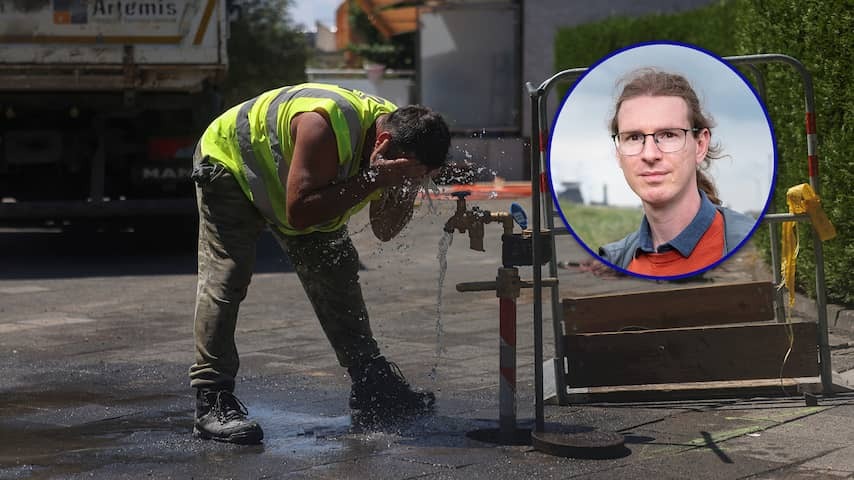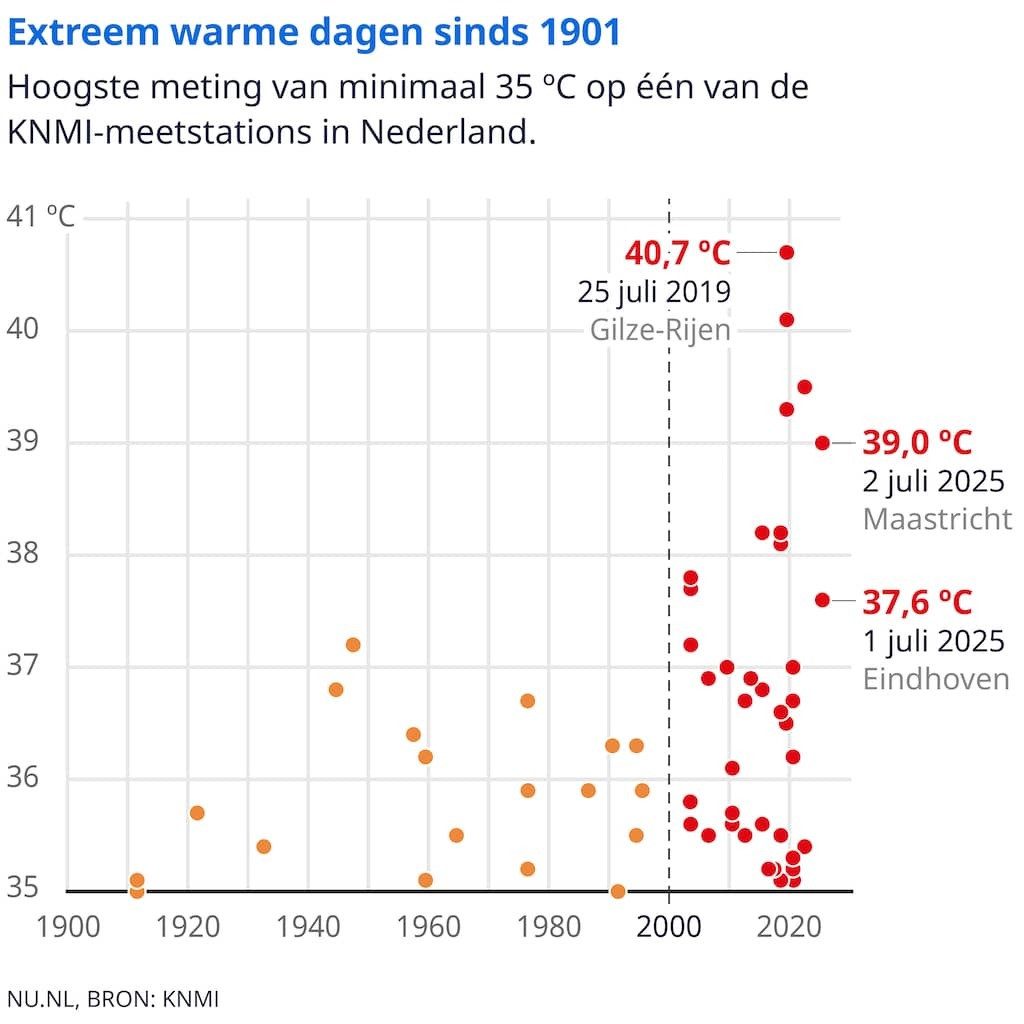
In the De Broeikas section, climate reporter Jeroen Kraan writes every week about what strikes him. This week: earlier generations of the Dutch did not know heat as we experienced this week. Unfortunately, there is no natural law that draws a limit with these extremes.
As a climate reporter, I regularly look at statistics about the weather in the Netherlands, but during a week like this you will be pressed back to the facts. Maybe it now feels like this kind of heat is ‘just’ part of the summer, but that is definitely not the case.
On Tuesday and Wednesday, temperatures were measured in the south of the Netherlands that never occurred in our country in the entire twentieth century. But if you start to find this heat normally, it is true somewhere.
Extremely hot days, with at least 35 degrees somewhere in the country, are increasingly common. Between 1900 and 2000, there were nineteen of that kind of days, in the last quarter century there were already 39:
In our summers we notice that Europe is the fastest warming continent in the world. For every degree global warming, the average temperature in Europe increases by 2 degrees. The hottest day of the year even warms up by 3.3 degrees per degree climate change.
Climate goal with an asterisk
Somehow it was appropriate that the European Commission had chosen this week to present the new climate goal for 2040. The emissions must then have fallen by 90 percent compared to 1990, according to European Commissioner Wopke Hoekstra. Or actually 87 percent, because thanks to a goat path, the European Union will soon be able to ‘purchase’ 3 percent emission reduction abroad.
From climate organizations, a lot of criticism of that weakening of the goal immediately came. That is understandable: this step was still emphatically discouraged by the most important scientific advisers of the committee. In addition, international CO2 credits in the past have often proved unreliable or even fraudulent. It is therefore a big question whether this 3 percent can be filled in a meaningful way.
Since the new European Commission has been taken on, EU climate plans have been nibbled before. For example, automakers were given longer to make their models more sustainable and there are advanced plans to weaken sustainability rules for business.
Yet it is good to keep an eye on the wider trend. With the new goal, the EU is continuing its climate price and remains very ambitious compared to other regions. The European sustainability stamp must be higher in the coming fifteen years than in the last fifteen years.
Denial has little to do with realism
In the meantime, elsewhere the knife really goes into greening. The United States are the most striking example. Under the reign of climate denier Donald Trump, green subsidies are massively abolished, climate scientists can grab their bags and the fossil industry is given a wide job. In the meantime, the most important official climate reports from the US government have been erased from the internet.
In Europe, too, the populist-right flank sounds louder and louder to put the climate policy in the bulky waste. Because climate denial in times of record heat is not really anymore and Vogue, that message is often packaged with terms such as “climate realism”.
Anyone who desperately went looking for a fan this week, had to get the children out of school earlier or have frantically googled how you get your house cool again, know that accepting a much more hot world has little to do with realism.
There is no natural law that ensures that the summer warming stops at 40 degrees. If the global temperature rises by 3 degrees, as is in danger of being the case at the end of this century, the outliers go over 45 degrees with us.
For the 1.7 billion inhabitants of India and Pakistan, the temperatures during heat waves then threaten to reach the unprecedented. Unfortunately, that scenario is realistic.
In The Section The Greenhouse , Climate Reporter Jeroen Kraan Writes Weekly about what he notices. This week: Earlier Generations of Dutch People did not experience heat like we did this week. Unfortunately, there is no law of nature that draws a line at these extremes.
As a Climate Reporter, I Regularly Look at Statistics About the Weather in the Netherlands, But Duration A Week Like This You Are Reminded Of The Facts. Perhaps it now feels as if this child of heat is ‘normal’ for the summer, but that is absolutely not the case.
On Tuesday and Wednesday, temperatures were Measured in the South of the Netherlands That had never occurred in our country in the Entire Twentieth Century. But if you start to find this heat normal, that is also somewhat correct.
Extremely Hot Days, with at Least 35 Degrees Somewhere in the Country, Are Becoming Increeasingly Common. While there were nineteen of these days between 1900 and 2000, there have already leg 39 in the past quarter century:

In our Summers we Notice That Europe, The Fastest Warming continent in the world. For Every Degree of Global Warming, The Average Temperature in Europe Increases by 2 Degrees. The Warmest Day of the Year Equally Warms by 3.3 Degrees per Degree of Climate Change.
Climate Target With An Asterisk
It was somewhat fitting that the European Commission had chosen this week to present the new climate target for 2040. Emissions must be reduced by 90 percent compared to 1990, accordance to European commissioner Wopke Hoekstra. Or Actual 87 percent, because thanks to a loophole, the European Union Will Soon Be Able to ‘Buy’ 3 percent Emission Reduction Abroad.
Climate Organizations Imediately Criticized the Weakening of the Target. This is understandable: This Step was explicitly discouraged by the commission’s main scientific advisors. In Addition, International CO2 Credits Have Often Proven Unreliable or Even Fraudulent in The Past. It is Therefore A Big Question Whether this 3 percent can be filled in in a meaningful way.
Since the new European Commission Toke Office, EU Climate Plans Have Been Tinkered with More Often. For Example, Automakers Were Given Longer to Make Their Models More Sustainable and There Are Advanced Plans to WEAKING Sustainability Rules for the Business Community.
Yet it is good to keep an eye on the broader trend. With the new target, the EU is continuing its Climate Course and Remains Very Ambitious Compared to Other Regions. The European Sustainability Pace Must Be Higher In The Next Fifteen Years Than In The Past Fifteen Years.
Denial Has Little to Do With Realism
Meanwhile, Elsewhere The Greening is Really Being Cut. The United States is The Most Obvious Example. Under the Rule of Climate Denier Donald Trump, Green Subsidies Are Being Massively Abolished, Climate Scientists Can Pack Their Bags And The Fossil Industry Is Getting Free Rein. Meanwhile, The Most Important Official Climate Reports from the American Government Have Been Wiped from the Internet.
In Europe, Too, The Call to Throw Climate Policy Into The Garbage, Becoming Increasingly Louder On The Populist-Right Flank is. Because climate denial is no Longer Really in Vogue in Times of Record Heat, That Message is of Packaged with Terms Such as “Climate Realism”.
Anyone who desperately searched for a fan this week, had to take the children out of school early or frantically googled how to cool their house knows that acceptance a much hotter world has little to do with realism.
There is no law of nature that ensures that summer warming stops at 40 degrees. If the global temperature rises by 3 degrees, as is likely to be the case at the end of this century, the outliers will exceed 45 degrees in our country.
For the 1.7 Billion Inhabitants of India and Pakistan, Temperatures Duration Heat Waves Threaten to Reach the Unsurvivable. Unfortunately, that scenario is realistic.